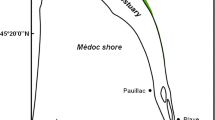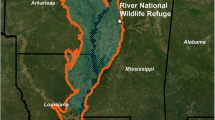Abstract
The Aquatic Warbler (Acrocephalus paludicola) is a song bird breeding in fen mires and similarly structured other wetlands with a water depth of 1–10 cm. Widespread in central-European wetlands at the beginning of the 20th century, the species is now globally threatened. The westernmost and genetically distinct Pomeranian population is even on the verge of extinction. The major challenge in the conservation of remaining habitat is the cost-efficient removal of biomass. About 50% of the Pomeranian population survives in a valley fen near Rozwarowo in Northwest Poland, where between 1993 and 2007 a conspicuous change in breeding habitat has taken place from summer grazed sedge meadows to commercial winter cut reed beds. We compared vegetation structure, site conditions, and potential prey abundance with the distribution and abundance of Aquatic Warblers in Rozwarowo Marshes and studied temporal changes and the compatibility of conservation and reed cutting interests. Aquatic Warblers now occur almost exclusively in sparsely growing, low reed with abundant Thelypteris palustris, Carex elata, and Lysimachia vulgaris. This vegetation type provides more potential prey for Aquatic Warblers than the higher productive tall reed, whereas the patches of sedge vegetation have become too small following succession after abandonment. Currently, commercial reed cutting maintains suitable Aquatic Warbler breeding habitat. Considering the impending changes in the reed market, there is a need for flexible agri-environmental schemes (AES) to ensure that stripes are left uncut and to prevent eutrophication by high and long flooding of the site.



Similar content being viewed by others
References
Aquatic Warbler Conservation Team (1999) World population, trends and conservation status of the Aquatic Warbler Acrocephalus paludicola. Vogelwelt 120:65–89
Bibby CJ, Lunn J (1982) Conservation of reedbeds and their avifauna in England and Wales. Biol Conserv 23:167–186. doi:10.1016/0006-3207(82)90074-X
BirdLife International (2000) Threatened birds of the world. Lynx Ediciones/BirdLife International, Barcelona and Cambridge
BirdLife International (2007) Species factsheet: Acrocephalus paludicola. http://www.birdlife.org. Cited 14 Nov 2007
Boar RR, Leeming DJ, Moss B (1991) The quality of thatching reed and its impact on the thatching industry. The links between water and sediment chemistry and reed quality. English Nature, Peterborough
Cowie NR, Sutherland WJ, Ditlhogo MKM, James R (1992) The effects of conservation management of reed beds. I. The flora and litter disappearance. J Appl Ecol 29:277–284. doi:10.2307/2404496
Dierschke H (1994) Pflanzensoziologie. Grundlagen und Methoden. Ulmer, Stuttgart
Ditlhogo MKM, James R, Laurence BR, Sutherland WJ (1992) The effects of conservation management of reed beds. I. The invertebrates. J Appl Ecol 29:265–276. doi:10.2307/2404495
Dreyer J (1913) Die Moore Pommerns, ihre geographische Bedingtheit und wirtschafts-geographische Bedeutung. XIV. Jahresbericht der Geographischen Gesellschaft zu Greifswald 1913–1914. Abel, Greifswald
Dyrcz A, Zdunek W (1993) Breeding ecology of the Aquatic Warbler Acrocephalus paludicola on the Biebrza marshes, northeast Poland. Ibis 135:181–189. doi:10.1111/j.1474-919X.1993.tb02830.x
Ellenberg H, Weber HE, Düll R, Wirth V, Werner W (1992) Zeigerwerte von Pflanzen in Mitteleuropa. Scr Geobot 18:1–258
Flade M, Giessing B, Pain D, Kozulin A (2006) Partial extinction: The case of the globally threatened Aquatic Warbler. J Ornithol 147(suppl):79
Frahm JP, Frey W (1992) Moosflora. Ulmer, Stuttgart
Giessing B (2002) Viele Väter für eine Brut—vorteilhaft oder unausweichlich für das Weibchen? Zum Paarungssystem und zur Populationsgenetik des Seggenrohrsängers (Acrocephalus paludicola). Dissertation, Köln University
Grime JP (1974) Vegetation classification by reference to strategies. Nature 250:26–31. doi:10.1038/250026a0
Grime JP, Hodgson JG, Hunt R (1988) Comparative plant ecology: a functional approach to common British species. Unwin Hyman, London
Gryseels M (1989) Nature management experiments in a derelict reedmarsh. I: effects of winter cutting. Biol Conserv 47:171–193. doi:10.1016/0006-3207(89)90063-3
Güsewell S, Le Nédic C (2004) Effects of winter mowing on vegetation succession in a lakeshore fen. Appl Veg Sci 7:41–48. doi:10.1658/1402-2001(2004)007[0041:EOWMOV]2.0.CO;2
Hawke CJ, José PV (1996) Reedbed management for commercial and wildlife interests. The Royal Society for the Protection of Birds, Sandy
Hill MO, Roy DB, Mountford JO, Bunce RGH (2000) Extending Ellenberg’s indicator values to a new area: an algorithmic approach. J Appl Ecol 37:3–15. doi:10.1046/j.1365-2664.2000.00466.x
Hodgson JG, Wilson PJ, Hunt R, Grime JP, Thompson K (1999) Allocating C-S-R plant functional types: a soft approach to a hard problem. Oikos 85:282–294. doi:10.2307/3546494
Jurzyk S (2004) Protection of Myrica gale L. brushwood in a peatbog under agricultural management. In: Wołejko L, Jasnowska J (eds) The future of Polish mires. Agricultural University of Szczecin, Szczecin
Jurzyk S, Wróbel M (2003) Co-occurrence of two species Molinia caerulea L. and “red-list” species Carex pulicaris L. in Western Pomerania (Poland). Pol J Ecol 51(3):363–367
Klotz S, Kühn I, Durka W (2002) BIOLFLOR—Eine Datenbank mit biologisch-ökologischen Merkmalen zur Flora von Deutschland. Schriftenreihe für Vegetationskunde 38. Bundesamt für Naturschutz, Bonn
Koska I, Succow M, Clausnitzer U, Timmermann T, Roth S (2001) Vegetationskundliche Kennzeichnung von Mooren (topische Betrachtung). In: Succow M, Joosten H (eds) Landschaftsökologische Moorkunde. Schweizerbart, Stuttgart
Kozulin A, Flade M (1999) Breeding habitat, abundance and conservation status of the Aquatic Warbler Acrocephalus paludicola in Belarus. Vogelwelt 120:97–111
Krogulec J, Kloskowski J (1999) Habitat selection of Aquatic Warbler Acrocephalus paludicola in Poland: consequences for conservation of the breeding areas. Vogelwelt 120:113–120
Krogulec J, Kloskowski J (2003) Monitoring Aquatic Warbler Acrocephalus paludicola in Poland. Ornis Hung 12–13:191–196
Kube J, Probst S (1999) Bestandsabnahme bei schilfbewohnenden Vogelarten an der südlichen Ostseeküste: welchen Einfluss hat die Schilfmahd auf die Brutvogeldichte? Vogelwelt 120:27–38
Leisler B (1981) Die ökologische Einnischung der mitteleuropäischen Rohrsänger (Acrocephalus, Sylviinae). I. Habitattrennung. Vogelwarte 31:45–74
Londo G (1984) The decimal scale for relevés permanent quadrats. In: Knapp R (ed) Sampling methods and taxon analysis in vegetation science. Handbook of vegetation science 4. Junk, The Hague
McCune B, Mefford MJ (1999) PC-ORD. Multivariate analysis of ecological data, version 4. MjM Software Design, Gleneden Beach
Mueller-Dombois D, Ellenberg H (1974) Aims and methods of vegetation ecology. Wiley, New York
Mühlenberg M (1993) Freilandökologie. Quelle & Meyer Verlag, Heidelberg
Pain D, Green RE, Giessing B, Kozulin A, Poluda A, Ottosson U, Flade M, Hilton G (2004) Using stable isotopes to investigate wintering areas and migratory connectivity of the globally threatened Aquatic Warbler Acrocephalus paludicola. Oecologia 138:168–174. doi:10.1007/s00442-003-1416-z
Pott R (1995) Die Pflanzengesellschaften Deutschlands. Ulmer, Stuttgart
Poulin B, Lefebvre G (2002) Effect of winter cutting on the passerine breeding assemblage in French Mediterranean reedbeds. Biodivers Conserv 11:1567–1581. doi:10.1023/A:1016866116220
Poulin B, Lefebvre G, Metref S (2000) Spatial distribution of nesting and foraging sites of two Acrocephalus warblers in a Mediterranean reedbed. Acta Ornithologica 35:117–121
Quinn GP, Keough MJ (2002) Experimental design and data analysis for biologists. Cambridge University Press, Cambridge
R Development Core Team (2007) R: a language and environment for statistical computing. R foundation for statistical computing, Vienna, Austria. ISBN: 3-900051-07-0, http://www.R-project.org/
Robel RJ, Press BM, Henning BL, Johnson KW, Blocker HD, Kemp KE (1995) Nutrient and energetic characteristics of sweep-collected invertebrates. J Field Ornithol 66:44–53
Schaefer M (ed) (2006) Brohmer—Fauna von Deutschland. Ein Bestimmungsbuch unserer heimischen Tierwelt, 22nd edn. Quelle & Meyer, Wiebelsheim
Schaefer HM, Naef-Daenzer B, Leisler B, Schmidt V, Müller JK, Schulze-Hagen K (2000) Spatial behaviour in the Aquatic Warbler (Acrocephalus paludicola) during mating and breeding. J Ornithol 141:418–424. doi:10.1007/BF01651571
Schmidt MH, Lefebvre G, Poulin B, Tscharntke T (2005) Reed cutting affects arthropod communities, potentially reducing food for passerine birds. Biol Conserv 121:157–166. doi:10.1016/j.biocon.2004.03.032
Schmidt MH, Rocker S, Hanafi J, Gigon A (2008) Rotational fallows as overwintering habitat for grassland arthropods: the case of spiders in fen meadows. Biodivers Conserv. doi:10.1007/s10531-008-9412-6
Schulze-Hagen K (1991) Acrocephalus paludicola (Vieillot 1817)–Seggenrohrsänger. In: Glutz von Blotzheim UN (ed) Handbuch der Vögel Mitteleuropas. Aula, Wiesbaden
Sellin D (1989) Vergleichende Untersuchungen zur Habitatstruktur des Seggenrohrsängers Acrocephalus paludicola. Vogelwelt 110:198–208
Sellin D (1990) Zum aktuellen Vorkommen des Seggenrohrsängers Acrocephalus paludicola im Oderdelta zwischen Peenestrom und Dziwna. Vogelwelt 111:181–189
Sieghardt H, Maier R (1985) Produktionsbiologische Untersuchungen an Phragmites-Beständen im geschlossenen Schilfgürtel des Neusiedler See. Wiss Arbeiten Burgenland 72:189–221
Southwood TRE (1978) Ecological methods: with particular reference to the study of insect populations. Chapman & Hall, London
Succow M, Joosten H (eds) (2001) Landschaftsökologische Moorkunde. Schweizerbart’sche Verlagsbuchhandlung, Stuttgart
Südbeck P, Andretzke H, Fischer S, Gedeon K, Schikore T, Schröder K, Sudfeldt C (eds) (2005) Methodenstandards zur Erfassung der Brutvögel Deutschlands. Dachverband Deutscher Avifaunisten, Radolfzell
Tanneberger F, Joosten H, Flade M (2005) An introduction to Aquatic Warbler conservation in Western Pomerania. In: Kotowski W (ed) Anthropogenic influence on wetlands biodiversity and sustainable management of wetlands. Warsaw Agricultural University Press, Warsaw
Tanneberger F, Bellebaum J, Fartmann T, Haferland HJ, Helmecke A, Jehle P, Just P, Sadlik J (2008) Rapid deterioration of Aquatic Warbler Acrocephalus paludicola habitats at the western margin of the breeding range. J Ornithol 139:105–115. doi:10.1007/s10336-007-0241-2
Tanneberger F, Bellebaum J, Dylawerski M, Fartmann T, Jurzik S, Tegetmeyer C, Wojciechowska M (accepted) Habitats of the globally threatened Aquatic Warbler (Acrocephalus paludicola) in Pomerania—vegetation and site characteristics. Bot Jahrb Syst Pflanzengesch Pflanzengeogr
Tegetmeyer C, Tanneberger F, Dylawerski M, Flade M, Joosten H (2007) The Aquatic Warbler—saving Europe’s most threatened songbird. Reed cutters and conservationists team up in Polish peatlands. Peatlands Int 2007 1:19–23
Wagner M, Kahmen A, Schlumprecht H, Audorff V, Perner J, Buchmann N, Weisse WW (2007) Prediction of herbage yield in grassland: how well do Ellenberg N-values perform? Appl Veg Sci 10:15–24. doi:10.1658/1402-2001(2007)10[15:POHYIG]2.0.CO;2
Wilson JD, Whittingham MJ, Bradbury RB (2005) The management of crop structure: a general approach to reversing the impacts of agricultural intensification on birds? Ibis 147:453–463. doi:10.1111/j.1474-919x.2005.00440.x
Wisskirchen R, Haeupler H (1998) Standardlisten der Farn- und Blütenpflanzen Deutschlands. Mit Chromosomenatlas von Focke Albers. Ulmer, Stuttgart
Acknowledgements
We thank the landowners for permission to work on Rozwarowo Marshes as well as Jochen Bellebaum, Lars Lachmann, Michael Manthey, and Michael Succow for valuable comments on the manuscript.
Author information
Authors and Affiliations
Corresponding author
Rights and permissions
About this article
Cite this article
Tanneberger, F., Tegetmeyer, C., Dylawerski, M. et al. Commercially cut reed as a new and sustainable habitat for the globally threatened Aquatic Warbler. Biodivers Conserv 18, 1475–1489 (2009). https://doi.org/10.1007/s10531-008-9495-0
Received:
Accepted:
Published:
Issue Date:
DOI: https://doi.org/10.1007/s10531-008-9495-0




